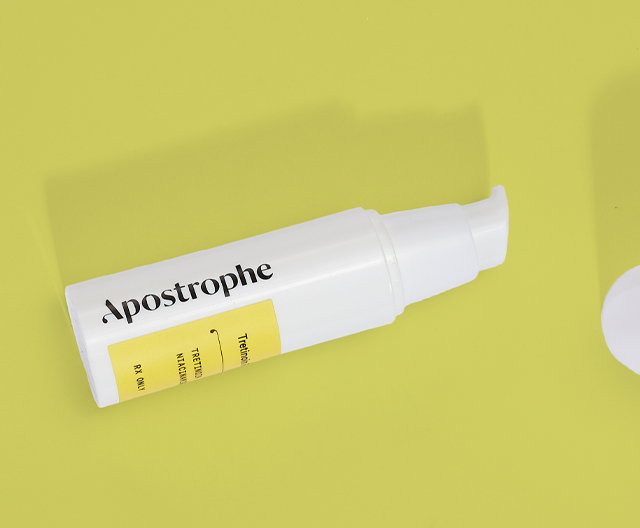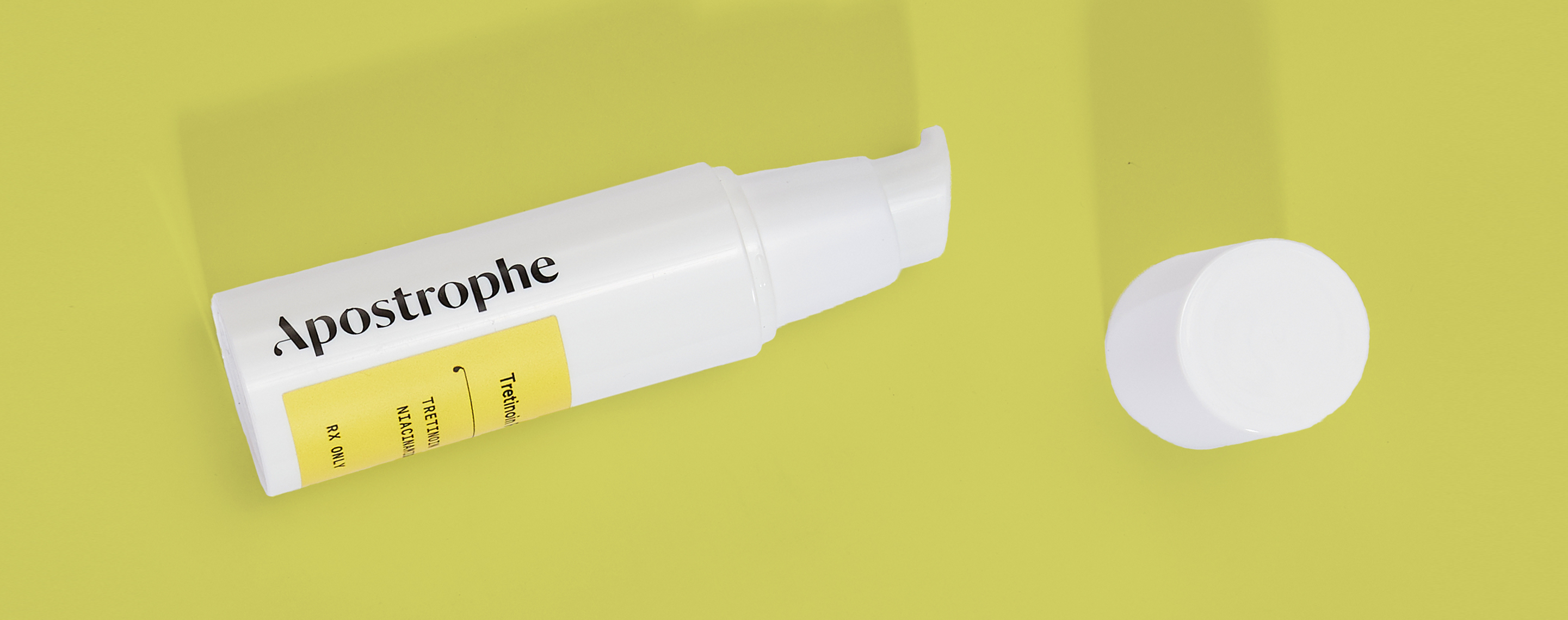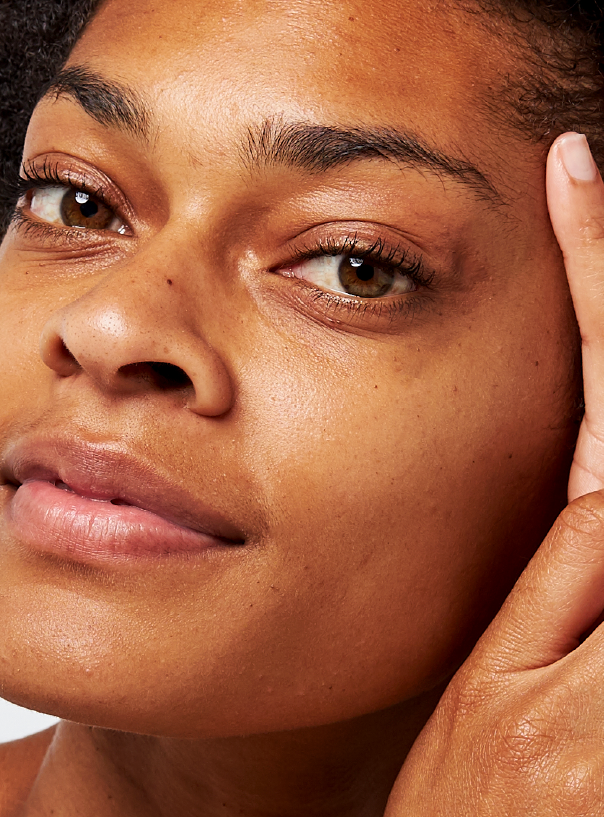Education
Azelaic Acid vs. Retinoids: What's the Difference? | Apostrophe


SHARE
Education
Azelaic Acid vs. Retinoids: What's the Difference? | Apostrophe
Medically reviewed by Aimee Paik, MD
Written by Apostrophe Team
Last updated 11/3/2024
Azelaic acid and retinoids are two popular words in the world of skincare, but what exactly are they? Many people compare the benefits of these strong ingredients with one another, but certain differences may make one option favorable over the other. Some dermatologists even prescribe these medications together in order to reap the various benefits of both.
To get a better idea of how these two types of ingredients work, read on to learn more about azelaic acid vs retinol, tretinoin, and other common retinoids!
What is Azelaic Acid?
First up on the chopping block: azelaic acid. This unique skincare ingredient may not be as well known as the retinoid family—but that doesn’t make it any less powerful. Let’s take a look at the basics of azelaic acid skin care products.
Azelaic acid belongs to the family of saturated dicarboxylic acids. This naturally occurring type of acid can be found in grain products like wheat or barley. When applied topically to the skin, azelaic acid provides several antimicrobial, anti-inflammatory, and pigment lightening effects.
What Does Azelaic Acid Treat?
Due to its unique properties, azelaic acid may be used to treat a wide variety of skin conditions. Most commonly, products with azelaic acid are prescribed for treatment of:
Acne
Rosacea
Hyperpigmentation
Azelaic acid's bacteria-killing, inflammation-reducing, and skin-lightening benefits cannot be achieved with most other skin care acids.
Does Azelaic Acid Cause Irritation?
Although azelaic acid may cause some irritation when first incorporated into your routine, particularly if you have a sensitive skin type, it’s generally considered a mild ingredient with similar efficacy to potentially harsher alternatives, such as benzoyl peroxide. In fact, this skincare product is mild enough that pregnant or breastfeeding women can continue to use it.
How Strong is Azelaic Acid?
Azelaic acid can be purchased over the counter, but stronger doses of the skincare ingredient will require a prescription from a doctor. The highest concentration found in azelaic acid products is usually 10% over-the-counter, while prescription options can contain up to 20%, which can help you see results faster. Depending on the plan your dermatology provider recommends, azelaic acid may be applied up to two times per day.
In a nutshell – Azelaic acid is like a skincare Swiss army knife. Treating a variety of skin conditions—including acne, rosacea, hyperpigmentation, and melasma—Azelaic Acid can be used daily with minimal risk of irritation. The main benefits azelaic acid boasts are its anti-inflammatory, antimicrobial, and pigment-lightening properties.
What Are Retinoids?
Now it’s time to switch gears and focus on one of skincare’s hottest buzzwords: Retinoids. This umbrella term refers to a large family of skincare ingredients with varying degrees of potency. However, all retinoids do share one thing in common—they’re extracted from Vitamin A.
What Makes Vitamin A So Special?
Before we can fully explain the benefits of retinoids, we must first understand the importance and effectiveness of Vitamin A on its own.
Vitamin A is a vital micronutrient that plays a number of roles in the human body. Most importantly (for skincare’s sake), Vitamin A stimulates collagen production in the skin. Simultaneously, Vitamin A also reduces levels of collagen-degrading matrix metalloproteinases—a.k.a., the enemy of collagen and healthy skin cells. While eating a diet rich in Vitamin A can help keep skin healthy and glowing, applying a topical derivative of this micronutrient can have even greater benefits.
What Do Retinoids Treat?
In addition to promoting collagen production and reversing sun damage that can cause premature aging, retinoids can also be used to treat a variety of other skin concerns. Because retinoids promote cell turnover, they may be prescribed in the course of acne treatment or to treat other inflammatory conditions, such as psoriasis. This is where azelaic acid and retinoids overlap.
Do Retinoids Cause Irritation?
Depending on their strength, products containing retinoids may lead to skin irritation. Luckily, skin irritation mainly occurs when you first start out with retinoids. With a bit of time, your skin should become accustomed to the treatment. While initial irritation is often a normal part of the process of treating your skin concerns, it’s important to discuss any worsening side effects with your dermatology provider when using a prescription-strength retinoid.
What Types of Retinoids Are There?
From OTC options to prescription-strength options, there are a number of different types of retinoids. While all of the ingredients in this family will eventually convert into retinoic acid and pass through the skin cell barrier, some retinoids prove more effective than others.
Among the long list of retinoids available, below are a few of the most common:
Retinol – Retinol is another form of Vitamin A that’s perhaps the most commonly known. Despite its popularity, not all retinol products are going to be the most effective in acne treatment or helping sun damage and signs of aging. Although retinol can successfully promote cell turnover and healthy skin, OTC products containing retinol are typically sold in lower, less effective doses.
Retinaldehyde – Because retinaldehyde only converts one time in order to become retinoic acid, it’s one of the gentlest retinoid options available. This easy passage through the skin also makes retinaldehyde more potent than many other OTC Vitamin A derivatives. However, prescription-strength retinoids will always provide better results than OTC retinoids.
Tretinoin – Tretinoin is a prescription-strength retinoid and one of the strongest ingredients found in skin care products. Due to its significant influence on skin cell turnover, tretinoin is used to treat moderate to severe acne, aging, and uneven skin texture. Dermatologists will typically instruct patients to start slowly with small amounts of tretinoin 2-3 nights a week when beginning this treatment, as this potent retinoid can often cause initial skin irritation and redness.
Tazarotene – Even stronger than tretinoin, tazarotene is an extremely potent retinoid used to treat severe cases of acne. This prescription-strength ingredient is only recommended for oily, acne-prone skin that is very resilient. Those with sensitive skin will most likely experience irritation when using tazarotene.
Isotretinoin – Commonly known as Accutane, isotretinoin is an oral retinoid used to treat severe cases of acne. This powerful ingredient is only recommended for patients who have not responded well to other retinoids as it requires close monitoring (including bloodwork) by a physician.
In a nutshell – Retinoids are a large family of Vitamin A derivatives with varying degrees of strength. Products that contain retinoids are designed to promote collagen production and increase cell turnover. For these reasons, retinoids may be used to treat a number of skin conditions, including sun damage, acne, and rosacea.
Azelaic Acid or Retinoids: Which is Better?
We understand how each of these ingredients works on their own, but how do they compare with one another? When it comes to treating your skin, should you choose azelaic acid or retinoids?
Ultimately, the best option for your skin care routine will depend on the following variables:
Your skin concerns – While azelaic acid and retinoids are both used to treat inflammatory conditions, such as acne and rosacea, retinoids are also used for their anti-aging benefits. If you’re looking for acne or rosacea treatment that can also promote anti-aging, retinoids can provide better results.
Your skin’s sensitivity – While azelaic acid comes in a smaller range of dosages, retinoids offer more variety in terms of strength. That being said, azelaic acid is generally considered gentler than tretinoin and will be more suitable for those with sensitive skin.
The root of the problem – While azelaic acid works to treat inflammation in particular, retinoids will have a stronger effect on cellular processes. Your dermatology provider can determine which of these ingredients will most effectively treat your skin concerns and provide long-term results.
Can Azelaic Acid and Retinoids Be Used Together?
Although azelaic acid and retinoids can treat some of the same conditions, they do so in different ways. For this reason, these two ingredients can actually be used in conjunction with one another—if recommended by a dermatology provider.
By combining azelaic acid’s anti-inflammatory properties with retinoids’ cellular benefits, patients may be able to reach an equilibrium in their skin care plan. Retinoids can work to promote healthy skin cells, while azelaic acid can reduce inflammation and prevent irritation and breakouts caused by the retinoid. Together they can also help fade dark spots.
Your Path to Gorgeous Skin Starts with Apostrophe
Trying to be your own dermatologist isn’t easy. While you may be able to effectively moisturize and exfoliate your skin, finding the right products to treat your specific skin concerns can be a challenge. Pairing products, like salicylic and azelaic acid, can be confusing as well.
Fortunately, Apostrophe is here to help. For only $20, you can get started with a virtual consultation, where a board-certified dermatologist will create a personalized skin care plan. Your prescribed treatment plan will be based on your skin’s unique needs. From acids to retinoids—and everything in between—Apostrophe will guide you every step of the way. The board-certified dermatologists on our platform can help answer any questions you may have from, “Can you use azelaic acid everyday?” to “When to use azelaic acid for optimal results?”
Reaching your skin goals has never been easier. Skip the office visit and get the expert dermatology care you need from the comfort of home today, with Apostrophe.
Sources:
Pubmed. Azelaic acid. A review of its pharmacological properties and therapeutic efficacy in acne and hyperpigmentary skin disorders.
https://pubmed.ncbi.nlm.nih.gov/1712709/
Apostrophe. Slather - Everything You Need to Know About Azelaic Acid. https://www.apostrophe.com/slather/everything-you-need-to-know-about-azelaic-acid/
Pubmed. Azelaic acid. A review of its pharmacological properties and therapeutic efficacy in acne and hyperpigmentary skin disorders.
https://pubmed.ncbi.nlm.nih.gov/1712709/
Pubmed. Retinoids: A Review.
https://pubmed.ncbi.nlm.nih.gov/6208221/
PubMed. Vitamin A antagonizes decreased cell growth and elevated collagen-degrading matrix metalloproteinases and stimulates collagen accumulation in naturally aged human skin.
https://pubmed.ncbi.nlm.nih.gov/10692106/
NCBI. Retinoids in the Treatment of Skin Aging. https://www.ncbi.nlm.nih.gov/pmc/articles/PMC2699641/
NCBI. Synchronizing Pharmacotherapy in Acne with Review of Clinical Care. https://www.ncbi.nlm.nih.gov/pmc/articles/PMC5527713/
Apostrophe. The Difference Between Retinol and Retinoids. https://www.apostrophe.com/slather/the-difference-between-retinol-and-retinoids/
Shop this post

Finacea (azelaic acid)

Tretinoin
Like what you just read? Sign up for our email list to get the scoop on skincare science delivered straight to your inbox.

Deep Dives
A dermatologist shares his thoughts on the recent studies about benzoyl peroxide and benzene.
Read More
Education
What is milia?
What is milia? Today, we’re jumping into one type of bump that you may have heard about most commonly in infants — milia.
Read More
Education
Best moisturizer for acne-prone skin
If you have combination acne-prone skin, figuring out which moisturizer is best for your skin might be tough. In this guide, we break down the best moisturizer for combination, acne-prone skin.
Read More
